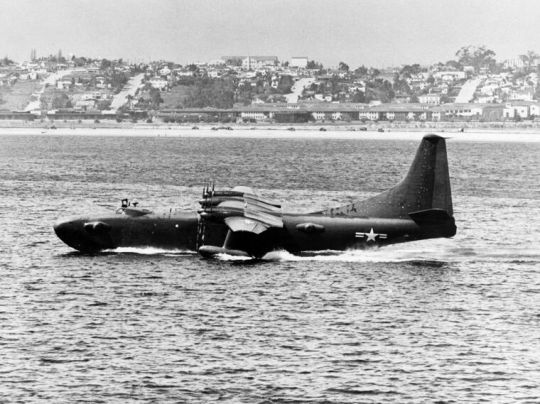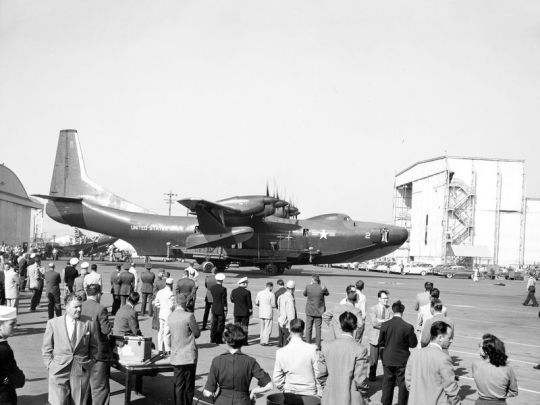#convair p5y
Explore tagged Tumblr posts
Text

Convair’s B-58... America’s first supersonic bomber - 1957.
#vintage advertising#vintage illustration#convair#convair p5y#convair r3y#convair skate#consolidated vaultee aircraft company#consolidated vaultee#vintage aircraft#military aircraft#jet bombers#delta dagger#f-102#jet fighters#b-58#b-58 hustler#f-102 delta dagger#supersonic bomber#supersonic aircraft#bombers
143 notes
·
View notes
Text
Ronnie Bell Following
Convair XP5Y-1 Tradewind
The Convair XP5Y-1 Tradewind on the day of its first flight on 18 April 1950 at San Diego, California (USA).
Date 18 April 1950.
The Convair R3Y Tradewind was an American 1950s turboprop-powered flying boat designed and built by Convair.
Convair received a requirement from the United States Navy in 1945 for a large flying-boat using the new technology developed during the war, especially the laminar flow wing and the developing turboprop technology. Their response, the Model 117 was a large, high-wing flying boat with Allison T-40 engines driving six-bladed contra-rotating propellers, a slender high-lift wing with fixed floats, and a sleek body with a single-step hull. The Navy ordered two prototypes on 27 May 1946. Designated XP5Y-1 the first aircraft first flew on 18 April 1950 at San Diego. In August the aircraft set a turboprop endurance record of 8 hours 6 minutes. The Navy decided not to proceed with the patrol boat version but directed that the design should be developed into a passenger and cargo aircraft.
Work continued despite the loss of one of the XP5Y-1s in a non-fatal accident on 15 July 1953. The transport and cargo version was designated the R3Y-1 Tradewind and first flew on 25 February 1954. Major changes were the removal of all armament and of the tailplane dihederal, the addition of a 10 ft (3.05m) port-side access hatch and redesigned engine nacelles to accept improved T40-A-10 engines. Cabin sound proofing and airconditioning were added and pressurised accommodation for 103 passengers or 24 tons of cargo. As a medivac aircraft 92 stretcher cases could be carried.
R3Y-2 variant loading a tractorThe first two built were in P5Y configuration, armed with 8,000 lb (3,600 kg) of stores (bombs, mines, depth charges, torpedoes) and 5 pairs of 20 mm cannon in fore and aft side emplacements and a tail turret. The next five were built as R3Y-1 aircraft, intended for troop transport and inflight refuelling tanker service. The final six were built as the R3Y-2 variant with a lifting nose and high cockpit (similar to modern-day eyes to the C-5 Galaxy's nose and cockpit) for heavier transport and landing-ship duties.
Eleven aircraft were built, of which six were front-loading R3Y-2 aircraft with a hinged nose and high cockpit; they were intended to be a Flying LST (landing craft). In practice, it was discovered that it was almost impossible for the pilots to hold the aircraft steady and nose on to the beach while the aircraft was loaded or unloaded. The aircraft were converted into tankers for the inflight refuelling role. They had a short service life because of the insoluble unreliability of their Allison T40 turboprop engines, a fate common to most T40-powered aircraft, such as the Douglas A2D Skyshark attack aircraft.
Via Flickr
2 notes
·
View notes
Text

- A Convair R3Y Tradewind transport sits on a cradle prior to being moved into San Diego Bay, 4 November 1954. | Photo: US Navy
FLIGHTLINE: 126 - CONVAIR R3Y TRADEWIND
The Tradewind was first ordered as a post-WWII patrol bomber, but was then changed to a transport before being canceled entirely.
After the end of WWII, the US Navy requested a new long range patrol bomber that would take advantage of the technologies developed during the war, including laminar flow wings and turboprop engines. Convair responded with the Model 117, a flying boat with a high wing, powered by Allison engines driving six-bladed contra-rotating props. Two prototypes of the plane, designated XP5Y-1 were ordered on 27 May 1946, with the first flight occurring on 18 April 1950.

-Orthograph of the P5Y-1 Tradewind. | Illustration: US Navy

-The Convair XP5Y-1 Tradewind on the day of its first flight on 18 April 1950. | Photo: US Navy
The P5Y were designed to carry 8,000lbs of weapons, and were armed with five pairs of 20mm cannon for self-defense. The T40 engine, which was essentially two T38 engines driving contra-rotating props via a common shaft, provided copious power, granting the plane with a maximum speed of 350mph and a climb rate of nearly 2,000 feet-per-minute, roughly that of a P-61 Black Widow. The design of the T40 also allowed for one of the power sections to be shut down for cruising, giving the plane a a range of 2,500 miles. In August of 1950, one of the YP5 prototypes set an endurance mark for turboprop aircraft of eight hours six minutes. A non-fatal accident destroyed one of the prototypes on 15 July 1953.

-Orthographs of the R3Y-1 and -2 models. | Illustration: US Navy
The rapid progress of technology post-war saw the Navy's interest in the Tradewind change, and Convair was ordered to modify the design into a transport. The changes included removing the defensive cannons, deleting the dihedral from the horizontal stabilizers, changes to the engine nacelles to fit upgraded T40-A-10 engines, the addition of soundproofing, air conditioning, and pressurization equipment for the cargo compartment, and a 10 foot hatch on the port side to load and unload cargo. The R3Y-1 could accommodate 103 passengers or twenty-four tons of cargo. First flight of the -1 variant was on 25 February 1954, with 5 total examples completed. Also in 1954, R3Y-1 "Coral Sea", using a strong jet stream, set a transcontinental speed record for seaplanes at 403mph.

-The 4 November 1954 public unveiling of the R3Y-1 Tradewind at Convair's plant in San Diego. | Photo: San Diego Air & Space Museum

-An RY3-1 on specialized beaching gear. | Photo: US Navy
The last six Tradewinds were R3Y-2 models, with the nose and crew compartment changed to include a swing-up nose which allowed for drive-on/drive-off cargo like jeeps and light armored vehicles. The Navy intended for these aircraft to be flying LSTs, with the aircraft directly unloading onto beachheads. In practice however, the aircraft, loaded or unloaded, were unable to hold steady and beach, and eventually all the Tradewinds were modified to act as aerial refueling tankers.

-A tractor being loaded onto an R3Y-2. | Photo: US Navy

-A R3Y-2 Tradewind set a record by simultaneously refueling four Grumman F9F-8 Cougar fighters in September 1956. | Photo: US Navy
The Tradewind had a short service life, with US Navy Transport Squadron 2 (VR-2) standing up with the plane on 31 March 1956, and the unit being disbanded and the type being grounded on 16 April 1958. Reliability problems with the T40 engine (which doomed the other aircraft that used the type, such as the Convair XFY and Lockheed XFV VTOL fighters, the Douglas A2D Skyshark and the Republic XF-84H Thunderscreech) as well as several incidents related to the props disintegrating mid-flight, as well as improvements in jet engines, ICBMs and changing strategies saw the end of seaplanes and flying boats.

-Four Tradewinds, two R3Y-1s and two -2s, flying over Alcatraz in 1957. | Photo: US Navy
#aircraft#aviation#avgeek#cold war#airplanes#airplane#cold war history#coldwar#aviation history#us navy#convair#convair r3y#r3y tradewind#tradewind#r3y-1#r3y 1#r3y 2#flying boat#seaplane#Transport plane
49 notes
·
View notes
Text

Engineering to the Nth power. In the air it’s Convair - 1952.
#vintage advertising#vintage illustration#convair#convair p5y#convair r3y#convair skate#consolidated vaultee aircraft company#consolidated vaultee#vintage aircraft#military aircraft#commercial aircraft#jet fighters#f-102#f-106#delta dart#delta dagger#sea dart
10 notes
·
View notes
